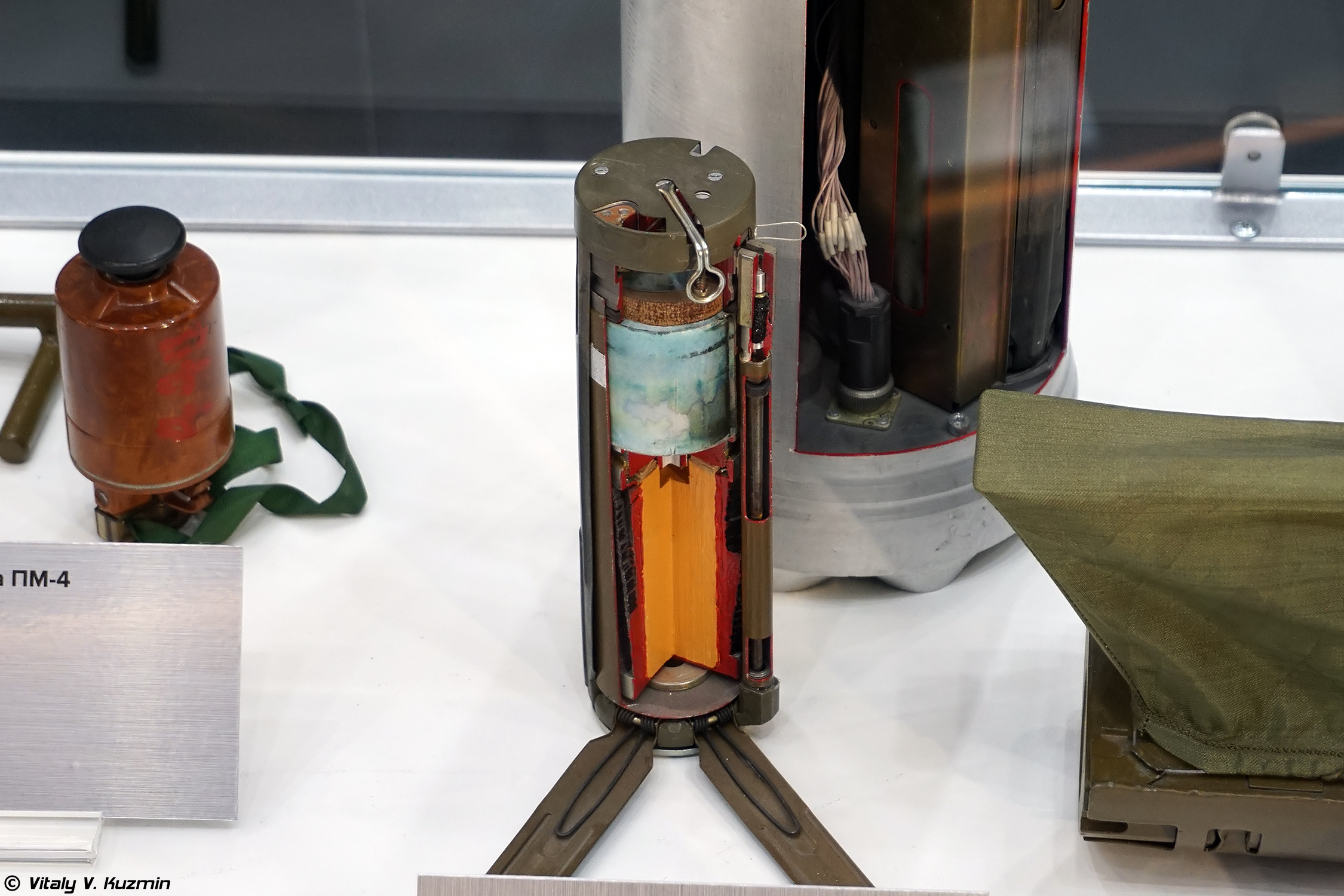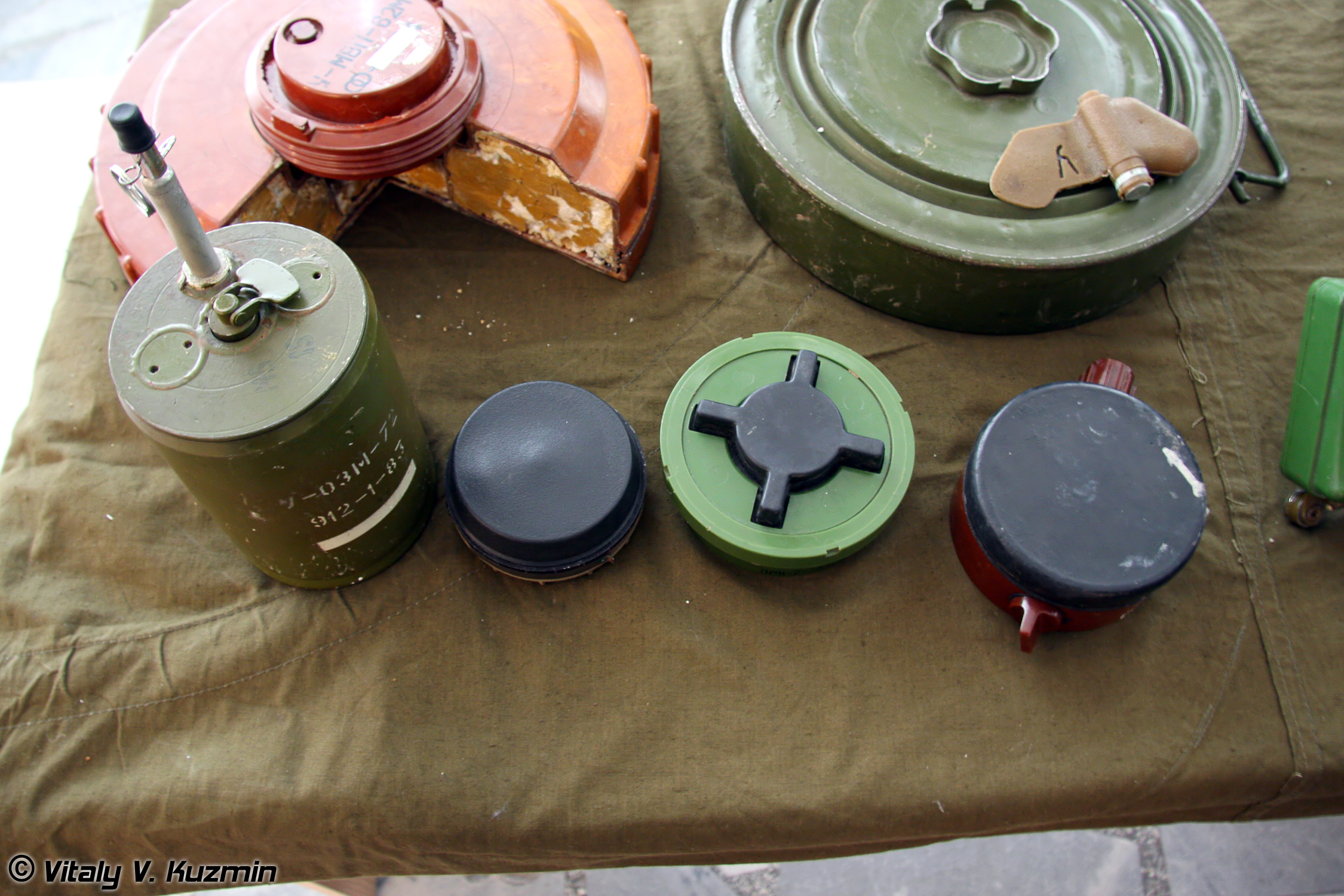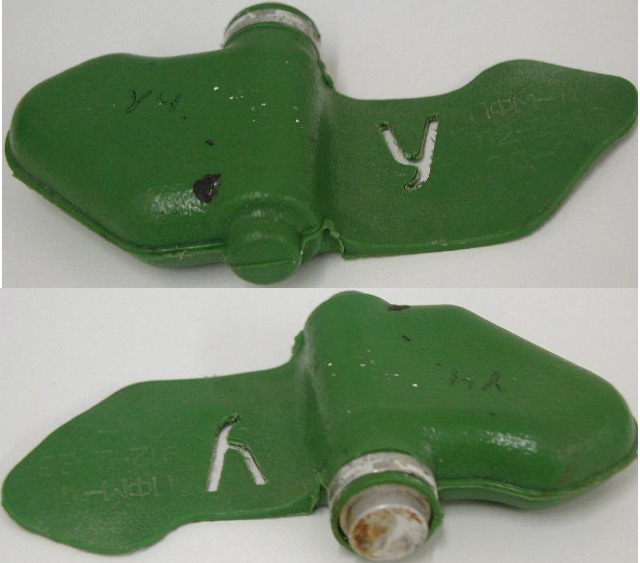|
PTM-3 Mine
The PTM-3 ( Russian: ПТМ-3: ПротивоТанковая Мина-3) is a Soviet scatterable self-liquidating shaped charge anti-tank mine. The mine's case is made up of a stamped steel body with notches in its side. The notches allow the mine to produce a shaped charge effect on five sides - 4 on the sides, and one on the end face. The mine has two arming stages - pyrotechnic and mechanical, and has a magnetic influence battery-powered fuze BT-06 ( Russian: БТ-06). The mine can be delivered using the BM-30 Smerch (9M55K4), BM-27 Uragan (9M59), BM-21 Grad (9M22K) MLRS, helicopter-mounted minelaying system VSM-1, remote mining machine UMZ ( Russian: УМЗ) or portable mining kit PKM ( Russian: ПКМ: Переносной Комплект Минирования). It cannot be placed manually, and must only be placed using remote minelaying systems listed above. Action The mine can only be deployed on soil with the use of various minelaying systems, within the KPTM-3 cass ... [...More Info...] [...Related Items...] OR: [Wikipedia] [Google] [Baidu] |
! Explosive Objects In War In Ukraine, 2022 (07)
The exclamation mark, , or exclamation point (American English), is a punctuation mark usually used after an interjection or exclamation to indicate strong feelings or to show emphasis. The exclamation mark often marks the end of a sentence, for example: "Watch out!". Similarly, a bare exclamation mark (with nothing before or after) is often used in warning signs. The exclamation mark is often used in writing to make a character seem as though they are shouting and/or excited/surprised. Other uses include: * In mathematics, it denotes the factorial operation. * Several computer languages use at the beginning of an expression to denote logical negation. For example, means "the logical negation of A", also called "not A". This usage has spread to ordinary language (e.g., "!clue" means no-clue or clueless). * Some languages use to denote a click consonant. History Graphically, the exclamation mark is represented by variations on the theme of a full stop point with a vertical ... [...More Info...] [...Related Items...] OR: [Wikipedia] [Google] [Baidu] |
Self-destruct
A self-destruct is a mechanism that can cause an object to destroy itself or render itself inoperable after a predefined set of circumstances has occurred. Self-destruct mechanisms are typically found on devices and systems where malfunction could endanger large numbers of people. Uses Land mines Some types of modern land mines are designed to self-destruct, or chemically render themselves inert after a period of weeks or months to reduce the likelihood of friendly casualties during the conflict or civilian casualties after the conflict's end. The Amended Protocol II to the Convention on Certain Conventional Weapons (CCW), amended in 1996, requires that anti-personnel land mines deactivate and self-destruct, and sets standards for both. Landmines currently used by the United States military are designed to self-destruct after between 4 hours and 15 days depending upon the type. The landmines have a battery and when the battery dies, the land mine self-destructs. The self-d ... [...More Info...] [...Related Items...] OR: [Wikipedia] [Google] [Baidu] |
Anti-tank Mine
An anti-tank mine (abbreviated to "AT mine") is a type of land mine designed to damage or destroy vehicles including tanks and armored fighting vehicles. Compared to anti-personnel mines, anti-tank mines typically have a much larger explosive charge, and a fuze designed to be triggered by vehicles or, in some cases, remotely or by tampering with the mine. History First World War The first anti-tank mines were improvised during the First World War as a countermeasure against the first tanks introduced by the British towards the end of the war. Initially they were nothing more than a buried high-explosive shell or mortar bomb with its fuze upright. Later, purpose-built mines were developed, including the Flachmine 17, which was simply a wooden box packed with explosives and triggered either remotely or by a pressure fuze. By the end of the war, the Germans had developed row mining techniques, and mines accounted for 15% of U.S. tank casualties during the Battle of Saint-M ... [...More Info...] [...Related Items...] OR: [Wikipedia] [Google] [Baidu] |
PMN Mine
The PMN () series of blast anti-personnel mines were designed and manufactured in the Soviet Union. They are one of the most widely used and commonly found devices during demining operations. They are sometimes nicknamed "black widow" because of their dark casings. PMN-1 The design of the PMN-1 mine dates from the late 1950s. It is particularly deadly because it contains an unusually large explosive filling when compared to most other anti-personnel landmines. For comparison, most anti-personnel blast mines (e.g. the VS-50) contain around 50 grams of high explosive, which typically destroys all or part of a victim's foot. In marked contrast, a PMN-1 contains 249 grams of explosive which can easily destroy a victim's entire leg (frequently requiring amputation high above the knee) in addition to inflicting severe injuries on the adjacent limb, which may also require some form of amputation due to blast injury. The majority of anti-personnel mine victims (e.g. those who step on an ... [...More Info...] [...Related Items...] OR: [Wikipedia] [Google] [Baidu] |
PFM-1
PFM-1 () is a scatterable high explosive anti-personnel land mine of Soviet and Russian production. It is also known as a Green Parrot or Butterfly Mine. The mines can be deployed from mortars, helicopters and aeroplanes in large numbers; they glide to the ground without exploding and will explode later upon contact. Design The mine consists of a polyethylene plastic container containing 40 g of explosive liquid. The two wings of the PFM-1 allow it to glide after being released in the air, then spin, stabilising it and slowing its descent. The thick wing contains the liquid explosive. The two wings together are 120 mm (about 5 inches) long. The plastic body can be moulded in a variety of colours for best camouflage. As existing stocks were in European green rather than sand coloured, the first examples used in 1980s Afghanistan were green and easily visible. This led to their name 'green parrots'. The shape and bright colour is attractive to children, inspiring claims that ... [...More Info...] [...Related Items...] OR: [Wikipedia] [Google] [Baidu] |
Machine Gun
A machine gun is a fully automatic, rifled autoloading firearm designed for sustained direct fire with rifle cartridges. Other automatic firearms such as automatic shotguns and automatic rifles (including assault rifles and battle rifles) are typically designed more for firing short bursts rather than continuous firepower, and are not considered true machine guns. As a class of military kinetic projectile weapon, machine guns are designed to be mainly used as infantry support weapons and generally used when attached to a bipod or tripod, a fixed mount or a heavy weapons platform for stability against recoils. Many machine guns also use belt feeding and open bolt operation, features not normally found on other infantry firearms. Machine guns can be further categorized as light machine guns, medium machine guns, heavy machine guns, general purpose machine guns and squad automatic weapons. Similar automatic firearms of caliber or more are classified as aut ... [...More Info...] [...Related Items...] OR: [Wikipedia] [Google] [Baidu] |
Explosive
An explosive (or explosive material) is a reactive substance that contains a great amount of potential energy that can produce an explosion if released suddenly, usually accompanied by the production of light, heat, sound, and pressure. An explosive charge is a measured quantity of explosive material, which may either be composed solely of one ingredient or be a mixture containing at least two substances. The potential energy stored in an explosive material may, for example, be * chemical energy, such as nitroglycerin or grain dust * pressurized gas, such as a gas cylinder, aerosol can, or BLEVE * nuclear energy, such as in the fissile isotopes uranium-235 and plutonium-239 Explosive materials may be categorized by the speed at which they expand. Materials that detonate (the front of the chemical reaction moves faster through the material than the speed of sound) are said to be "high explosives" and materials that deflagrate are said to be "low explosives". Explosi ... [...More Info...] [...Related Items...] OR: [Wikipedia] [Google] [Baidu] |
Self-destruct
A self-destruct is a mechanism that can cause an object to destroy itself or render itself inoperable after a predefined set of circumstances has occurred. Self-destruct mechanisms are typically found on devices and systems where malfunction could endanger large numbers of people. Uses Land mines Some types of modern land mines are designed to self-destruct, or chemically render themselves inert after a period of weeks or months to reduce the likelihood of friendly casualties during the conflict or civilian casualties after the conflict's end. The Amended Protocol II to the Convention on Certain Conventional Weapons (CCW), amended in 1996, requires that anti-personnel land mines deactivate and self-destruct, and sets standards for both. Landmines currently used by the United States military are designed to self-destruct after between 4 hours and 15 days depending upon the type. The landmines have a battery and when the battery dies, the land mine self-destructs. The self-d ... [...More Info...] [...Related Items...] OR: [Wikipedia] [Google] [Baidu] |
Earth's Magnetic Field
Earth's magnetic field, also known as the geomagnetic field, is the magnetic field that extends from Earth's interior out into space, where it interacts with the solar wind, a stream of charged particles emanating from the Sun. The magnetic field is generated by electric currents due to the motion of convection currents of a mixture of molten iron and nickel in Earth's outer core: these convection currents are caused by heat escaping from the core, a natural process called a geodynamo. The magnitude of Earth's magnetic field at its surface ranges from . As an approximation, it is represented by a field of a magnetic dipole currently tilted at an angle of about 11° with respect to Earth's rotational axis, as if there were an enormous bar magnet placed at that angle through the center of Earth. The North geomagnetic pole actually represents the South pole of Earth's magnetic field, and conversely the South geomagnetic pole corresponds to the north pole of Earth's magneti ... [...More Info...] [...Related Items...] OR: [Wikipedia] [Google] [Baidu] |
Shaped Charge
A shaped charge is an explosive charge shaped to form an explosively formed penetrator (EFP) to focus the effect of the explosive's energy. Different types of shaped charges are used for various purposes such as cutting and forming metal, initiating nuclear weapons, penetrating armor, or perforating wells in the oil and gas industry. A typical modern shaped charge, with a metal liner on the charge cavity, can penetrate armor steel to a depth of seven or more times the diameter of the charge (charge diameters, CD), though greater depths of 10 CD and above have been achieved. Contrary to a misconception (possibly resulting from the acronym for '' high-explosive anti-tank'', HEAT) the shaped charge EFP jet does not depend in any way on heating or melting for its effectiveness; that is, the EFP jet from a shaped charge does not melt its way through armor, as its effect is purely kinetic in nature – however the process does create significant heat and often has a signific ... [...More Info...] [...Related Items...] OR: [Wikipedia] [Google] [Baidu] |
VSM-1 Mine System
VSM-1 ( Russian: ВСМ-1—Вертолетная Система Минирования-1) is a Soviet helicopter-based remote mining system. It can be mounted on various variants of the Mil Mi-8 helicopter, particularly the Mi-8T and Mi-8MT. It is capable of deploying a range of high explosive and fragmentation mines. The system was developed by the State Research Engineering Institute (ГНИИИ) and was manufactured by the Kazan Helicopter Production Association, which was renamed to Kazan Helicopters in 1993. It is still being produced and used today by the Russian Armed Forces. Action The VSM-1 system is made up of 4 containers, a PUM-1V ( Russian: ''ПУМ-1В'') control panel, a PKPI-1 ( Russian: ''ПКПИ-1'') control device, a PP-1V ( Russian: ''ПП-1В'') electronics test panel and a container lifting & suspension system. Depending on the configuration, a Mi-8 equipped with VSM-1 can spray from 116 to 8352 mines in under a minute. This allows the creation of minef ... [...More Info...] [...Related Items...] OR: [Wikipedia] [Google] [Baidu] |
BM-21 Grad
The BM-21 "Grad" (russian: БМ-21 "Град", lit= hail) is a self-propelled 122 mm multiple rocket launcher designed in the Soviet Union. The system and the M-21OF rocket were first developed in the early 1960s, and saw their first combat use in March 1969 during the Sino-Soviet border conflict. ''BM'' stands for ''boyevaya mashina'' ( ru , боевая машина – combat vehicle), and the nickname means "hail". The complete system with the BM-21 launch vehicle and the M-21OF rocket is designated as the M-21 field-rocket system. The complete system is more commonly known as a Grad multiple rocket launcher system. In NATO countries the system, either the complete system or the launch vehicle only, was initially known as the M1964. Several other countries have copied the Grad or have developed similar systems. In Russian service its intended replacement is the 9A52-4 Tornado. Many similar 122 mm MLRS systems are made by different countries based on the BM-21 Grad. ... [...More Info...] [...Related Items...] OR: [Wikipedia] [Google] [Baidu] |
.jpg)






